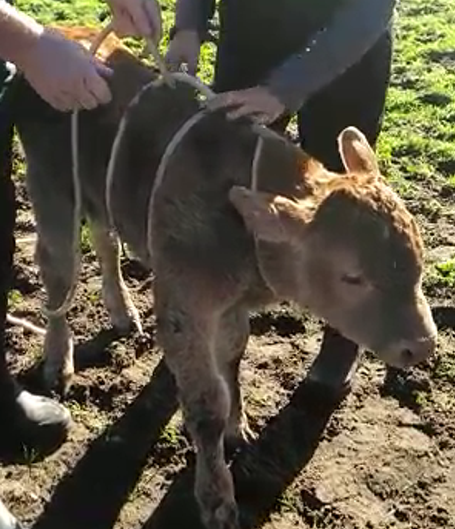
https://ec.europa.eu/eip/agriculture/en/find-connect/projects/bovine-beef-innovation-network-europe
Author: G. Stilwell
Calves born showing the typical behaviour of dummy calves - indifference to environmental stimuli, lack of affinity for the dam, failure to find the udder, refuse to suck even when helped by putting the teat in its mouth, aimless wandering or motionless standing – die or need costly and prolonged care for obvious reasons. In dummy foals the “Madigan squeeze technique” has been used for years with apparent success.
 Photo: George Stilwell
Photo: George StilwellPhysical compression of the chest helps newborn foals with neonatal maladjustment syndrome. The compression induces a slow wave sleep and hormone changes similar to what occurs during delivery when there is a neonatal transition from neuroinhibition to neuroactivation.
This technique has now also be used in calves. Calves are subjected to the squeezing technique for 20 minutes. A soft cotton rope, approximately 3 cm wide, is passed around the calves’ chest and abdomen. The calves are then forced to lie down while the loop around the chest is tightened. After a short struggled, easily controlled by one person on the head, calves go into a deep sleep that is manifested by closed eyes, no limb movement, slow breathing and bradycardia. Noise, wind or human presence apparently did not disturb these calves that usually do not move for the entire 20 minutes of the experiment. The calves are then awaken and the rope removed. They get up after a few seconds and walked towards the dam to suckle. They then behave like a normal new-born animal.
The Madigan squeeze technique seems to be beneficial for maladjusted calves, when there is no apparent reason (e.g. trauma, acidosis, disease) for extreme dullness. It can be a chance to reduce calf mortality and/or the need for after birth care.
So far the technique has been used on foals for long but it is a completely new approach for calves. It has been tested on calves by George Stilwell and several practitioners.
The Madigan squeeze technique might be a way to safe calves showing maladjustment syndrome with very small investment in time or money. However, Success is still small as the technique has not been used wisely and a thorough clinical examination should precede the use of the technique. During the BovINE project two demonstration videos have produced about the technique. The first one shows the sucessful use of the squeeze, click here. The second one descibes the attachement of the rope (in German), click here.
 Video by Martha d’Andrade & George Stilwell
Video by Martha d’Andrade & George StilwellCalves showing maladjustment syndrome can be saved with very small investment in time or money.
Links:
Demonstration in Ireland (IFA)
Demonstration in Portugal (FMV)
Demonstration in Germany (FLI)
Literature:
Stilwell, G. et al. (2019): Potential benefit of a thoracic squeeze technique in two newborn calves delivered by caesarean section. New Zeland Veterinary Journal 68, 65-68.
Impact:
- Animal health and welfare: This technique reduces the time, treatment cost and handling normaly involved in management of calves with Neonatal Maladjustment Syndrome (NMS). It also allows to save calves that would not be able to follow the dam and would only be detected (in beef herds) when severely debilitated or dead. Nevertheless, this technique should be performed only by a veterinarian as a complete clinical examination should always precedd the squeeze, Using the squeeze on animals with conditions other than NMS is dangerous as it delays adequate treatment and can lead to pain, lesions, trauma and death.
- Production efficiency and meat quality: labour time decreases because the care for dummy claves reduces to a minimum time (time for squeeze); no extra time for giving colostrum etc.
Hier klicken, um den Artikel auf Deutsch zu lesen.